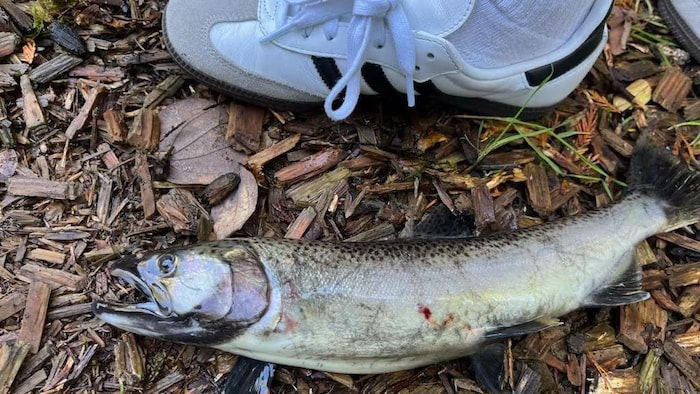Open in full screen mode A rubber-preserving chemical compound commonly used in car tires may be the cause of the deaths of dozens of coho salmon in West Vancouver's Brothers Creek. (File photo) The Canadian Press Wildlife conservation activist groups have written to Canada's environment minister for a review of a chemical used in tire manufacturing to be carried out. According to them, its degradation is linked to the massive death of coho salmon. Peter Ross, senior scientist at the Raincoast Conservation Foundation, says the mystery of coho deaths in urban waterways persisted for years. In 2020, a study uncovered the role of a particular chemical used in tire rubber. Peter Ross explains that #x27;study published in Science (New window) (in English), a leading academic journal, found that a chemical known as 6PPD-quinone causes degradation that is extremely toxic to coho. He says the study showed toxic concentrations of 6PPD after rain fell in watersheds in the Seattle area in the northwest United States, suggesting that it flowed off the roads and into streams. According to Science magazine, 6PPD-quinone is a chemical compound intended to prevent ozone damage to the rubber of tires, preventing rapid degradation. Raincoast, Watershed Watch Salmon Society and the Pacific Salmon Foundation, all based in British Columbia, are asking Ottawa for an assessment of the suspected chemical under the Canadian Environmental Protection Act. Loading ELSELSE ON INFO: Anger rumbles among Quebec farmers A letter was sent this week to the Minister of the Environment, Steven Guilbeault. She recalls that the Government of Canada assessed 6PPD in 2018, concluding that it presented a moderate hazard at high exposure, but that the screening did not take into account degradation of the product. Peter Ross says a growing body of research links the breakdown substance 6PPD to the deaths of coho salmon when the fish return from the Pacific Ocean to spawn. This breakthrough came after scientists conducted research for 20 years. They looked at all the potential culprits, from hydrocarbons to parasites to road salts. Peter Ross observed that these scientists eventually discovered that a previously undocumented chemical was the culprit. Peter Ross reports that it is very difficult to establish cause and effect relationships between a single pollutant and the health of salmonids. These fish are in fact exposed to several thousand different chemicals and pollutants during their lives. Several groups in British Columbia are currently working to monitoring 6PPD-quinone in waterways on southern Vancouver Island, among others.
Anger rumbles among Quebec farmers
Coho salmon deaths: Activists write to Canadian Environment Minister

